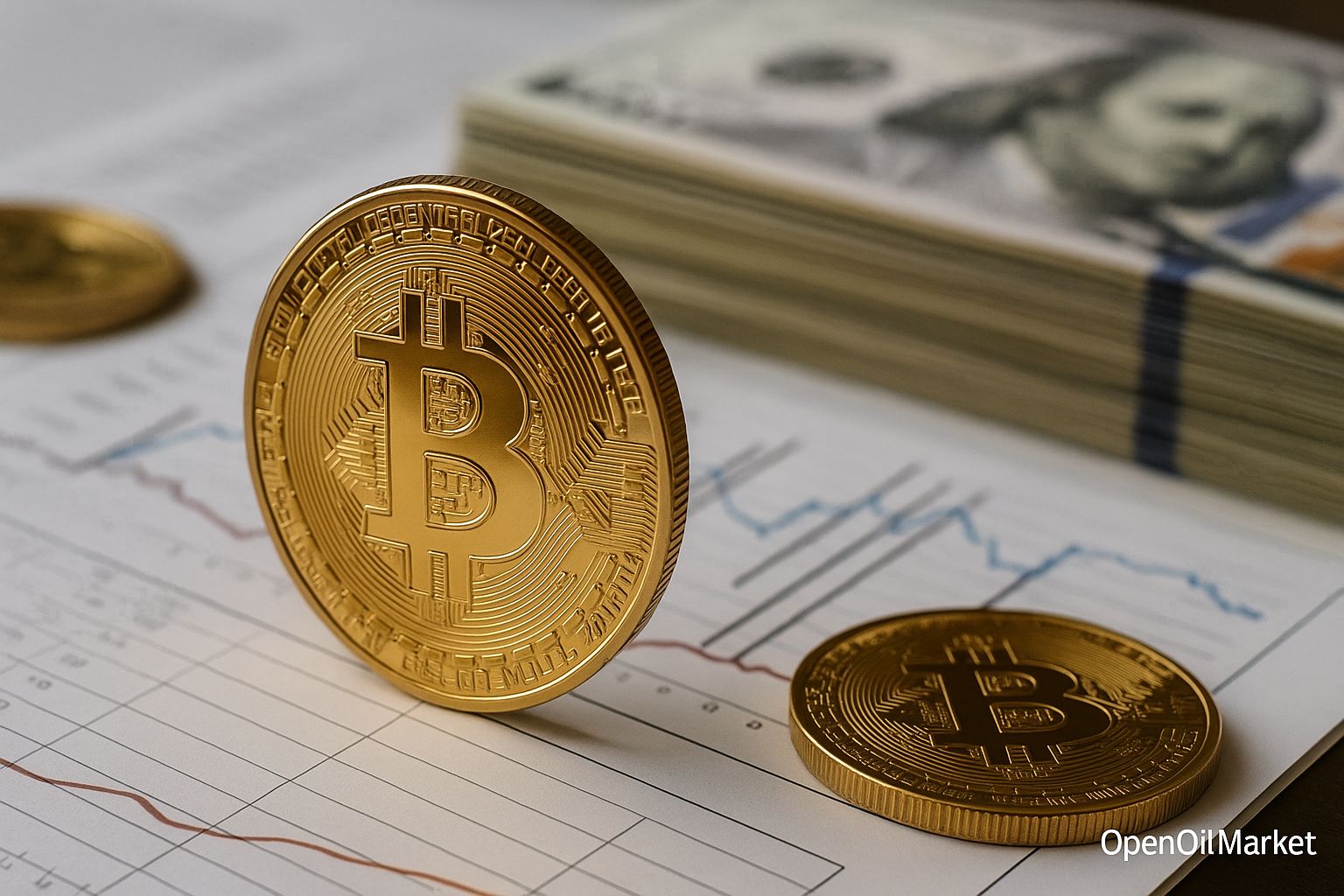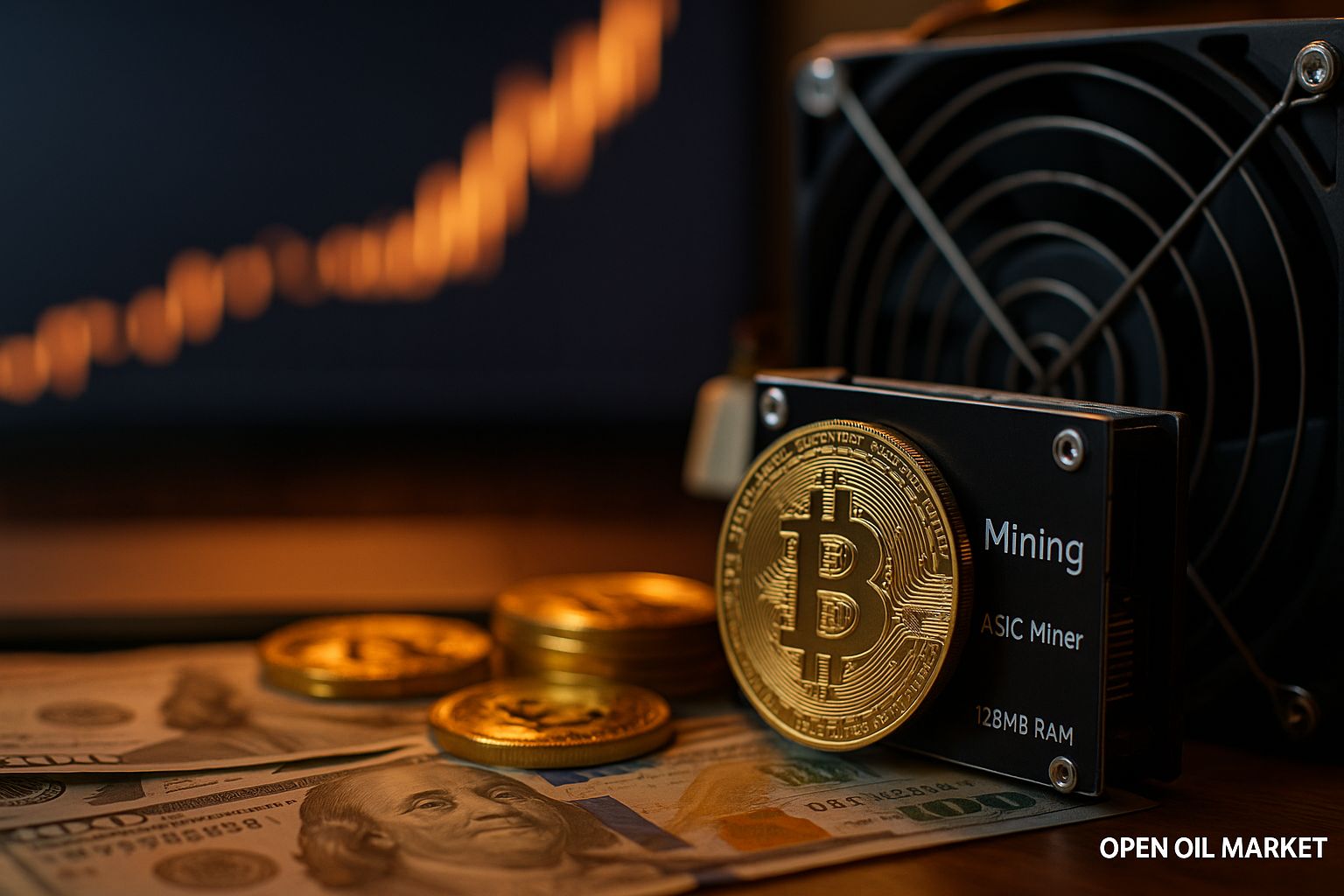USD Coin (USDC) Price Forecast for May 2025
What is USD Coin and Its Current Price
USD Coin (USDC) is one of the largest stablecoins, a type of cryptocurrency pegged to the value of traditional assets; in this case, the US dollar. The issuer of USDC is Circle, which backs every issued coin with real dollar reserves, primarily consisting of US Treasury bonds. As a result, the price of USD Coin remains consistently close to $1.00, reflecting the dollar's value. In other words, the exchange rate of USD Coin is equivalent to that of the US dollar: the market price of USDC tends to hover around $1. For users from Russia, this means that USDC converts to rubles at the current dollar exchange rate (for example, with a rate of 1 USD ≈ 80 RUB, 1 USDC would be about 80 rubles). In real trading, there can be slight fluctuations in the USDC price around parity (for instance, $0.99–$1.01), but overall, the price of USD Coin remains steadily pegged to $1.
USDC is issued on the Ethereum blockchain (ERC-20 standard); however, this is not the only option for its deployment: currently, USD Coin is available on 19 different blockchain networks (including Algorand, Solana, Polygon, and others) to enhance accessibility and transaction speed. This allows investors to transfer and use USDC across various ecosystems. If you need to purchase USDC, you can do so on major cryptocurrency exchanges (such as Bybit and others), where the token is traded against both fiat currencies and other crypto assets. Notably, the USDC/USDT pair is actively used on exchanges, allowing for direct exchanges between USD Coin and Tether (USDT) at nearly a 1:1 rate. The high liquidity of USDC on platforms like Bybit ensures a minimal spread during exchanges, enabling traders to easily buy or sell USDC at market prices without significant deviations.
Key Market and Macroeconomic Factors Influencing Stablecoin Prices
Despite being pegged to the dollar, the USDC price is indirectly influenced by overall market and macroeconomic conditions. Stablecoins serve as a bridge between traditional finance and the crypto market, meaning that changes in the global economic environment can impact the demand and stability of these assets. Below, we examine the main factors:
1. Trust and Reserve Backing. A key factor in the price stability of USD Coin is the trust that each coin is backed by reserves. Circle publicly reports on USDC’s reserves, holding a significant portion in secure assets (such as US Treasury bonds). The transparency and reliability of these reserves mean that even during market turmoil, holders can expect to exchange 1 USDC for 1 US dollar. When trust is undermined—such as in March 2023 when part of USDC's reserves became temporarily inaccessible due to the collapse of Silicon Valley Bank, causing the price of USDC to drop to ~$0.88—the market reacts with sell-offs. However, prompt action from regulators and Circle (including deposit guarantees and reserve replenishments) quickly restored the USDC peg to the dollar. Thus, the reliability of banking partners and the overall situation in the financial system (including the stability of dollar reserves) directly impacts USDC's ability to maintain its 1:1 exchange rate.
2. Global Interest Rates and Yields. The monetary policy of leading countries affects the appeal of stablecoins. In high interest rate environments in the US, investors may prefer to keep funds in bank deposits or bonds; however, stablecoin issuers benefit as reserve yields increase. Between 2023 and 2024, the Federal Reserve's rate hike boosted Circle and Tether's income on reserves, strengthening stablecoins' financial stability. At the same time, high rates may have slightly reduced speculative interest in cryptocurrencies, but stablecoins remain in demand as a means of capital storage within the crypto ecosystem. If interest rates decline in 2025 amid a loosening of monetary policy, it could lead to increased liquidity in markets and a rise in stablecoin issuance for new investments in crypto assets. Conversely, tightening policies potentially reduce the growth of the stablecoin supply, although the baseline USDC rate will still remain pegged to the dollar.
3. Geopolitics, Inflation, and Demand for Digital Dollars. In developing economies with unstable national currencies, dollar-denominated stablecoins become a popular means of saving and hedging against inflation and devaluation. For instance, residents of countries with high inflation rates or currency restrictions (capital controls) actively purchase USDT and USDC to preserve savings in "digital dollars." This process is known as crypto-dollarization, transitioning to the use of dollar-pegged cryptocurrencies instead of local currencies. Increased demand for stablecoins in such regions can lead to temporary price premiums—occasionally USDC/USDT trades slightly above $1 in countries where access to dollars is complicated, as individuals are willing to pay a premium for a digital dollar. However, globally, such imbalances are typically smoothed out by arbitrageurs. In Russia, for example, the price of USD Coin in rubles directly depends on the USD/RUB exchange rate; when the ruble weakens, the price of USDC in rubles rises, stimulating interest in stablecoins as a way to protect capital from the depreciation of the national currency. Thus, macroeconomic instability and geopolitical risks (sanctions, restrictions on currency transfers) boost demand for USDC, indirectly influencing its market capitalization and turnover.
4. The Role of Stablecoins in the Crypto Market. Stablecoins are an integral part of the cryptocurrency market infrastructure, providing liquidity for trades and serving as an intermediary asset for conversions between various cryptocurrencies. In 2024-2025, the cryptocurrency market is witnessing growth (with BTC surpassing historical highs in early 2025), and along with this, the aggregate demand for stablecoins as a means of entering and exiting volatile positions has risen. The total market capitalization of all stablecoins reached approximately $230 billion, reflecting their significance. As trading activity revives in 2025, USDC is increasingly used as collateral on derivatives platforms (for instance, futures, settlement in USDC on exchanges like Bybit) and for settlements between companies. The expansion of real use cases—in payments and cross-border transfers—also enhances the fundamental demand for stablecoins. For example, entrepreneurs can accept payments in USDC for export services, bypassing expensive bank transfers, making USD Coin an attractive tool for international settlements. These market factors (trading volumes, integration into payments) do not change the price of USDC (which remains around $1), but they influence liquidity, turnover, and the market capitalization of the stablecoin.
Market Capitalization Dynamics of USDC and Its Comparison with USDT
USD Coin is the second-largest stablecoin in the world by market capitalization, trailing only Tether (USDT). The competition between USDC and USDT has been one of the key discussions in the stablecoin market over the past few years. Let's examine how their market capitalization and market shares have changed:
Growth of USDC and Surge of USDT. During the crypto boom of 2020-2021, both stablecoins rapidly gained traction: investors poured in capital, and issuance grew by billions. By early 2022, USDC confidently secured second place, with its capitalization exceeding $50 billion, approaching the then-$78 billion of USDT. By mid-2022, following the collapse of the algorithmic stablecoin TerraUSD, there was a rise in trust towards fully backed stablecoins—including USDC—resulting in an increased share for USD Coin. However, Tether managed to maintain its lead. Market tensions in the autumn of 2022 (the bankruptcy of FTX) and in 2023 played into the hands of the older USDT: investors, especially in Asia, continued to trust USDT, while USDC faced temporary difficulties accessing banking reserves in March 2023. Following the collapse of several American banks, Circle announced the freezing of part of its reserves (at Silicon Valley Bank), leading to a short-term outflow from USDC. Consequently, the market capitalization of USD Coin dropped from ~$56 billion to ~$24.5 billion in 2023, and USDC's market share shrank. In contrast, Tether relatively quickly regained lost ground: by April 2023, USDT's capitalization returned to pre-crisis levels, while USDC's recovery took longer.
Current Metrics and Power Balance. In early 2025, amid a revival in the cryptocurrency market, USD Coin is once again showing a growth in trust and issuance. According to data from CoinMarketCap and Circle, as of late April 2025, approximately $60-62 billion in USDC is in circulation—this is a record historical figure, up 40% from the beginning of the year. Thus, USDC has not only recovered from the decline of 2023 but has also reached new highs in capitalization, indicating a resurgence of market interest. However, during the same period, Tether solidified its leadership even further: its supply exceeded $145 billion USDT, which is more than twice the volume of USDC. According to Citi, USDT (~$145 billion) remains the largest stablecoin, while USDC ($60 billion) occupies second place, collectively accounting for the lion's share (~90%) of the entire stablecoin market. Consequently, for every 1 USDC in circulation, there are approximately 2.4 USDT—significantly favoring Tether.
This ratio reflects the different approaches and spheres of dominance of these projects. USDT has historically been popular among retail traders in Asia and on the Tron platform (where fees are minimal), whereas USDC is more widespread in the regulated financial services segment, DeFi, and among Western institutional investors due to its transparency reputation. After the exit of the BUSD stablecoin (Binance's project limited the issuance of BUSD in 2023 under regulatory pressure), market shares redistributed in favor of USDT and USDC, with both issuers picking up BUSD users and strengthening their positions. An important indicator is the market share of USDC relative to USDT, which has begun to grow again by 2025. If at the beginning of 2023, USDC accounted for less than 25% of the total volume of stablecoins, it is now about 27%, while USDT's share is around 63%. So far, USDT retains more than half of the market, but USDC's successes (a 40% growth within just a few months in 2025) indicate that competition is intensifying. Moving forward, the relationship between USDC and USDT will depend on user trust, technological advantages (such as USDC's multi-chain solutions versus USDT's broad coverage) and, of course, the regulatory conditions for each issuer.
Regulatory Events and Circle News: The Impact on USDC
The regulatory environment is one of the determining factors affecting the development of stablecoins and their perceived value (in terms of stability of backing). In recent years, important events have occurred around Circle and the stablecoin industry:
-
Circle's IPO and Stablecoin Legalization. In early 2025, Circle announced plans to go public through an IPO, targeting a valuation of up to $5 billion. The stock placement is expected to take place in spring 2025. This move is seen as a signal of the industry's maturation: stablecoins are increasingly recognized by the traditional financial system. Raising capital through the IPO will bolster Circle's financial base and allow it to expand services for institutional clients. Back in 2021, Circle attempted to enter the stock market through a SPAC merger, but the deal fell through in 2022 due to a tougher regulatory stance (SEC led by Gary Gensler). Now, with a more favorable regulatory climate in the US, Circle has renewed its listing plans. The new administration in Washington in 2025 demonstrates a softer stance towards the crypto industry, encouraging innovation and even declaring its intention to make the US a "global crypto hub." As a result, the Securities and Exchange Commission (SEC) has suspended or closed several lawsuits against crypto companies, reducing some legal uncertainties. For USDC, Circle’s public listing means enhanced company transparency, strengthened trust from investors and users, and an influx of new partners from the traditional financial sector. This positively impacts the stability of the stablecoin and its future usage prospects.
-
Promotion of Stablecoin Regulation in the US. Alongside Circle's initiative, a regulatory framework for stablecoins is being established in the US. The administration has issued an executive order on developing federal regulation for digital assets, and Congress is discussing stablecoin legislation that may establish reserve and licensing requirements for issuers. Clarity of rules in the US could significantly strengthen USDC's position, as Circle has initially adhered to transparency and compliance policies. Citi notes in its April report that regulatory certainty will allow for deeper integration of stablecoins into the financial system and expand their usage in payments. Thus, if a comprehensive stablecoin law is passed in 2025, Circle is likely to become one of the first companies to receive an official license in the US, enhancing USDC's competitive advantage. On the other hand, risks could arise: overly stringent requirements (such as complete banking regulation of issuers) may raise costs for Circle. Nevertheless, the current trend appears to be positive, as authorities recognize the benefits of stablecoins for the economy and seek to legalize and regulate them rather than ban them.
-
MiCA in the EU and Circle's Global Expansion. Regulatory shifts are also occurring outside of America. In 2024, the European Union approved the MiCA (Markets in Crypto-Assets) regulation, establishing rules for crypto-assets, including stablecoins, within the EU. Circle has proactively prepared for these requirements and declared that USDC has become the first major stablecoin compliant with MiCA regulations in the EU. This has allowed the company to maintain and expand access to the European market without disruptions for users. Additionally, Circle launched USDC in Japan in collaboration with the financial group SBI in 2024, taking advantage of updated regulations in Japan permitting the use of foreign stablecoins on licensed platforms. Japan has traditionally had a strict stance on stablecoins, and the arrival of USDC in this market is a significant event, opening up a new user base. In the Middle East region, Circle is also making strides: in April 2025, the company received preliminary approval from the regulator in Abu Dhabi to provide services as a payment operator. Expanding its presence in crypto-friendly jurisdictions (UAE, Singapore, Switzerland, etc.) protects USDC from local regulatory risks and creates a global accessibility network. All these licensing and partnership news bolster confidence that USD Coin complies with legislation and is less susceptible to sudden bans or sanctions. Consequently, the price of USDC remains stable; investors do not expect the token to vanish from markets due to regulatory actions; rather, they see it as a reliable instrument.
-
Competition from New Players and Events. In 2023-2024, new stablecoins from major fintech companies entered the market—such as PayPal USD (PYUSD) launched by PayPal. While their scale is currently limited, competition from PayPal, central bank digital currencies (CBDCs), or other stablecoins prompts Circle to maintain high standards of transparency and innovation. In 2025, Circle launched a cross-border payment network based on USDC, aiming to enhance the token's utility in international settlements. Additionally, the company supports initiatives to integrate USDC into traditional banking. Regulators, witnessing such moves, increasingly view stablecoins not as threats but as a part of the financial infrastructure. International organizations (IMF, Bank for International Settlements) are issuing recommendations for the oversight of stablecoins to minimize systemic risks. So far, neither the US nor the EU has implemented strict restrictions on the use of USDC by individuals. However, investors should stay alert for updates: any sudden bans on stablecoins (for example, a hypothetical ban on conversions at banks) could negatively impact the market and cause price deviations. As of May 2025, there are no such signals—rather, the news indicates increasing integration of USDC into the regulated space, creating favorable conditions for stable pricing.
USD Coin Price Forecast for May 2025
Considering the factors mentioned above, our forecast for the price of USD Coin (USDC) in May 2025 suggests that it will maintain a stable peg to the US dollar, meaning it will hover around $1.00 for 1 USDC. Unlike volatile cryptocurrencies, the price of the stablecoin USDC is not determined by traditional supply and demand dynamics—it will remain at $1 as long as trust in Circle's reserves is not shaken. In May 2025, we do not anticipate events that could disrupt parity: the US economy, while undergoing changes in monetary policy, does not show signs of severe disturbances (such as massive bank bankruptcies or stablecoin bans) on the horizon. On the contrary, many recent trends—successful IPO of Circle, easing of regulations, global expansion of USDC—provide a robust foundation for USD Coin's stability.
The expected price of USDC in dollars will remain within a narrow range of $0.999–$1.001 on exchanges. Minor deviations from parity may occur during peak market volatility, but these are generally quickly mitigated by arbitrage traders. The forecast for USDC's price in rubles will depend on the dynamics of the ruble against the dollar. Assuming the USD/RUB exchange rate remains close to current levels, the price of 1 USDC in May 2025 will be approximately 80–85 rubles. Consequently, if the ruble strengthens against the dollar, USDC will decrease in ruble terms, and if the ruble weakens, it will increase in price, although the USDC dollar rate will still remain at $1. For investors using USD Coin as a store of value, it is important to remember that the main risks do not lie in fluctuations of the token's price itself, but in possible extraordinary situations—such as technological or regulatory issues that could temporarily disrupt the exchange mechanism of 1 USDC = $1. However, the likelihood of such developments in May 2025 is assessed as low.
The fundamental factors supporting the stability of USDC remain strong: reserve assets are reliable and liquid, global regulatory bodies are beginning to recognize the legitimacy of stablecoins, and the market shows a high demand for digital dollars for payments and trading. Moreover, Circle holds 100% of its reserves in high-quality liquid assets and undergoes regular audits, meaning even in times of stress, the company has the resources to withstand mass redemption requests for USDC. Thus, our price forecast for USD Coin in May 2025 is $1.00. We anticipate that USDC will continue to serve as a digital equivalent of the dollar without losing its peg.
In conclusion, for investors and traders, USD Coin (USDC) will remain a reliable safe haven in a volatile cryptocurrency market. Key metrics to monitor in May 2025 include the market capitalization of USDC (which could continue to grow, narrowing the gap with USDT) and regulatory news (legislation, new licenses for Circle), although they have more long-term impacts than on immediate price. Under stable conditions, the price of USDC will likely remain around $1, providing market participants with confidence in the price stability of this asset. Any deviation from this course will immediately attract arbitrage and actions from the issuer to restore the peg, thus the likelihood of significant price changes for USDC in May 2025 is minimal. USDC continues to live up to its designation as a stablecoin, offering a combination of fiat currency reliability and blockchain convenience—qualities that have made it one of the key tools in the digital economy.
Sources: Market data and capitalization facts about USDC/USDT are taken from reports by CoinDesk, Bloomberg, and Citi: Coindesk notes that approximately $62 billion USDC is in circulation (+40% since the beginning of 2025), with a total stablecoin capitalization of around $230 billion. Citi indicates volumes of ~$145 billion for USDT and ~$60 billion for USDC at the beginning of 2025. Bloomberg reported on the recovery of USDC's capitalization to $56 billion in February 2025 after dropping to $24.5 billion in 2023. Regulatory shifts (Circle's IPO, easing SEC policies) are covered in analytical articles by PYMNTS. Information on the popularity of stablecoins in inflationary conditions is drawn from IMF materials. These data support the forecast that USD Coin will maintain a stable rate in May 2025, trading at approximately one US dollar per coin.




